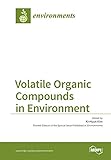Volatile Organic Compounds in Environment
Material type: ArticleLanguage: English Publication details: MDPI - Multidisciplinary Digital Publishing Institute 2017Description: 1 electronic resource (VIII, 122 p.)ISBN:
ArticleLanguage: English Publication details: MDPI - Multidisciplinary Digital Publishing Institute 2017Description: 1 electronic resource (VIII, 122 p.)ISBN: - 9783038425120
- 9783038425137
Open Access star Unrestricted online access
Volatile organic compounds (VOCs) are released from both static and mobile sources (e.g., industrial, transport, household, fossil fuels use, and many other sources). They are emitted into the atmosphere, taken up by plants, and ingested by animals to be bio accumulated along the food chain up to the apex predator. Many of these pollutants are classified as being toxic/carcinogenic by varying degrees and pose a worldwide risk to the environment and human health. Exposure (through different exposure pathways, i.e., inhalation, dermal absorption, ingestion, etc.) to those hazardous pollutants can damage the immune, neurological, reproductive (e.g., reduced fertility), developmental, and respiratory systems of humans and animals. More efforts are thus needed to improve the method of their detection and treatment. This Special Issue aims to present articles emphasizing more than one of all the available tools to monitor or treat VOCs: (1) measurement techniques for VOC; (2) treatment techniques for VOC; and (3) all important environmental issues associated with the management of VOCs.
Creative Commons https://creativecommons.org/licenses/by-nc-nd/4.0/ cc https://creativecommons.org/licenses/by-nc-nd/4.0/
English
There are no comments on this title.

